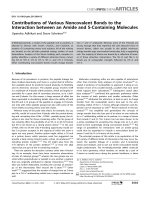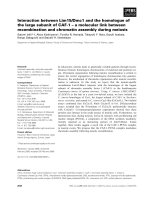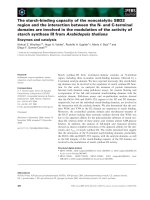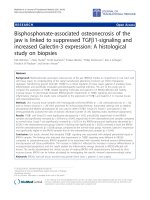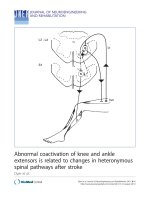Interaction between COMT rs5993883 and second generation antipsychotics is linked to decreases in verbal cognition and cognitive control in bipolar disorder
Bạn đang xem bản rút gọn của tài liệu. Xem và tải ngay bản đầy đủ của tài liệu tại đây (471.02 KB, 9 trang )
Flowers et al. BMC Psychology (2016) 4:14
DOI 10.1186/s40359-016-0118-3
RESEARCH ARTICLE
Open Access
Interaction between COMT rs5993883 and
second generation antipsychotics is linked
to decreases in verbal cognition and
cognitive control in bipolar disorder
Stephanie A. Flowers1, Kelly A. Ryan2, Zongshan Lai2,3, Melvin G. McInnis2 and Vicki L. Ellingrod1,2*
Abstract
Background: Second generation antipsychotics (SGAs) are increasingly utilized in Bipolar Disorder (BD) but are
potentially associated with cognitive side effects. Also linked to cognitive deficits associated with SGA-treatment are
catechol-O-methyltransferase (COMT) gene variants. In this study, we examine the relationship between cognition in
SGA use and COMT rs5993883 in cohort sample of subjects with BD.
Methods: Interactions between SGA-treatment and COMT rs5993883 genotype on cognition was tested using
a battery of neuropsychological tests performed in cross-sectional study of 246 bipolar subjects.
Results: The mean age of our sample was 40.15 years and was comprised of 70 % female subjects. Significant
demographic differences included gender, hospitalizations, benzodiazepine/antidepressant use and BD-type diagnosis.
Linear regressions showed that the COMT rs5993883 GG genotype predicted lower verbal learning (p = 0.0006) and
memory (p = 0.0026) scores, and lower scores on a cognitive control task (p = 0.004) in SGA-treated subjects.
Interestingly, COMT GT- or TT-variants showed no intergroup cognitive differences. Further analysis revealed an
interaction between SGA-COMT GG-genotype for verbal learning (p = 0.028), verbal memory (p = 0.026) and
cognitive control (p = 0.0005).
Conclusions: This investigation contributes to previous work demonstrating links between cognition, SGA-treatment
and COMT rs5993883 in BD subjects. Our analysis shows significant associations between cognitive domains such as
verbal-cognition and cognitive control in SGA-treated subjects carrying the COMT rs5993883 GG-genotype. Prospective
studies are needed to evaluate the clinical significance of these findings.
Keywords: Cognition, Second generation antipsychotic, COMT, Bipolar disorder
Background
Second generation Antipsychotics (SGAs) are distinguished from first generation antipsychotics by the ability
to control psychosis at doses associated with considerably
fewer extrapyramidal symptoms and a relatively greater 5HT2A/D2 binding affinity ratio [1]. This class of medication is increasingly utilized in the long-term treatment of
Bipolar Disorder (BD) as an alternative monotherapy or
* Correspondence:
1
Clinical Pharmacy Department, College of Pharmacy, University of Michigan,
428 Church St, Ann Arbor, MI 48109-106, USA
2
Department of Psychiatry, School of Medicine, University of Michigan, 4250
Plymouth Rd, Ann Arbor, MI 48109, USA
Full list of author information is available at the end of the article
more often as an adjunct treatment with lithium or anticonvulsant agents. Significant underlying cognitive deficits
in BD patients have not only been observed in manic or
depressive episodes but also when euthymic, compared to
healthy controls [2–4]. Various medical or lifestyle factors
may influence cognitive functioning in this patient population but the contribution of pharmacologic treatment to
deficits in cognition remains unclear. In schizophrenia,
evidence suggests that cognitive improvements after the
initiation of treatment have more to do with practice effects such as exposure, familiarity and/or procedural
learning than the implementation of second generation
antipsychotics [5]. However, there remains an abundance
© 2016 Flowers et al. Open Access This article is distributed under the terms of the Creative Commons Attribution 4.0
International License ( which permits unrestricted use, distribution, and
reproduction in any medium, provided you give appropriate credit to the original author(s) and the source, provide a link to
the Creative Commons license, and indicate if changes were made. The Creative Commons Public Domain Dedication waiver
( applies to the data made available in this article, unless otherwise stated.
Flowers et al. BMC Psychology (2016) 4:14
of recent findings to suggest there are cognitive effects
associated with SGA-treatment. Unlike the cognitive benefits observed in some studies for SGA therapy in the
schizophrenia population [6–8], evidence indicates that
SGAs may have a further detrimental effect on cognition
in BD independent of other clinical factors [9, 10]. These
data highlight the need to investigate this issue in a large,
well-characterized sample of patients with BD.
Previous studies have shown that the regulation of dopamine and dopamine receptors play a role in BD pathophysiology and also in cognitive processes [11, 12]. Contributing
to dopamine signaling pathways are both environmental
and genetic factors. Catechol-O-methyltransferase (COMT)
is a major enzyme involved in dopamine metabolism in
the prefrontal cortex and has been associated with numerous psychiatric phenotypes [13–15]. The COMT
Val108/158Met polymorphism (rs4680) and Val allele
load is associated with decreased cognitive performance, such as in executive functioning and working
memory in both schizophrenia and BD subjects [16–19].
Although not thoroughly characterized, other COMT
variants impacting cognition in BD subjects have been
described [16, 20]. The objective of this study was to
compare neuropsychological performance of SGA vs
non-SGA treated bipolar patients with different allelic
representation of the COMT variants. As previous associations link cognition deficits to treatment with
SGAs and COMT variant alleles in the BD population,
we hypothesize this COMT variant would result in
decreased cognitive scores in BD patients who are
treated with SGAs.
Methods
Subjects
The Prechter Longitudinal Study of Bipolar Disorder is
an ongoing observational study of bipolar disorder at the
University of Michigan (HUM00000606) with the main
goal of gathering phenotypic data and biological material
[21]. The present study included 246 individuals from
this cohort with a DSM-IV diagnosis of BD (BD Type I
(n = 178), BD Type II (n = 39), BD not otherwise specified (NOS, n = 21), Schizoaffective disorder-bipolar type
(n = 8)). All subjects underwent an evaluation using the
Diagnostic Interview for Genetic Studies (DIGS; [22]),
neuropsychological testing, clinician questionnaires to
assess symptoms of depression and mania (Hamilton
Depression Rating-17 item (HDRS; [23]) and Young
Mania Rating Scale (YMRS; [24]). Diagnoses were confirmed using a best estimate process by at least three
MD/PhD clinicians. Medication groups were defined as
the use of an SGA at the time of cognitive testing. Second generation antipsychotics, concomitant benzodiazepines and antidepressants used by our cohort are listed
in Additional file 1: Table S1. For this cross-sectional
Page 2 of 9
analysis, the medication treatment class, neuropsychological performance, age, gender, years of education,
time since BD diagnosis, treatment with benzodiazepines
or antidepressants and number previous hospitalizations
were noted in these subjects.
Neuropsychological tests
Neuropsychological tests were administered by trained
research associates under the supervision of licensed clinicians. The test battery was intended to emphasize
known areas affected by BD illness and reported in our
prior work [4, 25]. Five specific tests were selected from
the original test battery to capture areas that seem to be
most sensitive to COMT variants. The California Verbal
Learning Test-II (CVLT-II, [26]) was used a measure of
verbal learning and memory. In this task, five consecutive trials of 16 words are presented and overall learning
across the 5 trials was recorded. There was a short-term
delayed free recall trial after a distractor list and a longterm delayed free recall trial after 20 min. The ReyOsterrieth Complex Figure Test (Rey, [27, 28]) was used
as a measure of visual learning and memory and required subjects to draw from memory a complex figure
that they previously copied and then to recall from
memory the figure again after 20 min. To assess executive functioning, the Wisconsin Card Sorting Test
(WCST, [29]), a measure of novel problem solving task,
and the Trail Making Test (Parts A and B: TMT, [30]), a
measure of set-shifting and sequencing, were administered. For the WCST, subjects had to sort cards according to a sorting strategy that they learned based on
receiving feedback about prior sorts. Number and type
of errors were recorded as well as how many categories
sorted. For the TMT Part A, subjects had to manually
connect dots in order of numbers that were presented in
a spatial array. For the TMT Part B, subjects had to alternate connecting numbers and letters. Total seconds
to complete each task was recorded. To assess cognitive
control (the ability to engage and disengage in response
behaviors), often seen as an element of attention, we
used the Parametric Go/No-Go task (PGNG, [31]), a
computerized continuous performance test that consists
of three separate levels, but only the first level was used
for this study. The first level measures attention and
response time, resulting in two measures of cognitive
control. Subjects respond to a serial stream of letters,
pressing a keyboard as quickly as possible whenever they
see specific letter.
Genotyping
Genotyping was done using the HumanCoreExome-12v1
DNA Analysis BeadChip Kit (Illumina, INC., San Diego,
CA). Samples were genotyped for greater than 240,000
tagSNP markers and more than 240,000 exome markers
Flowers et al. BMC Psychology (2016) 4:14
by the University of Michigan DNA Sequencing Core.
DNAs were quantified using the Quant-iT™ PicoGreen®
dsDNA Kit (Invitrogen Corporation, Carlsbad, CA) and
samples were assayed according the Illumina Infinium® HD
Ultra Protocol. BeadChip image data was recorded using
an Illumina iScan Mircroarray Scanner with the Infinium
NXT scan setting. Sample image data were analyzed and
genotypes determined using the Illumina GenomeStudio
(v2011.1) DNA Analysis Software package with Genotyping Modulue (v1.9.4) using the HumanCoreExome-12v10_B Manifest and HumanCoreExome-12v1-0_B Cluster
file from Illumina. To limit false positives, we conducted a
priori analysis with COMT due to previous associations
with COMT variants and cognition. Two SNPS available
for analysis were COMT rs5993882 and rs165599. Initial
data for rs165599 did not show any association with SGA
use and cognition and therefore, we focused our analysis
on rs5993882.
Statistical analyses
Hardy–Weinberg equilibrium was tested by a Chi Square
analysis. Demographic differences between treatment
groups were examined with a standard t-test or one-way
ANOVA for continuous variables and a chi-square for
nominal variables. We performed linear regressions for
the multiple variable analyses. For the first linear regression, the cognitive test scores in treatment groups (SGAtreated vs. non-SGA treated) were compared for the three
COMT rs5993882 genotypes (GG, GT, TT). We adjusted
the model for known predictors that may confound cognitive performance, such as age, years of education, gender,
diagnosis, benzodiazepine or antidepressant concomitant
use, and prior hospitalizations. For tests that were statistically significant, we additionally ran a follow-up analysis
using chlorpromazine (CPZ) equivalents as a continuous
variable. The second linear regression also was adjusted
for these covariates but included new predictors such as
COMT genotype and an SGA- COMT interaction. In the
second regression model, the GG COMT genotype was
used as the comparator for the combined GT and TT
genotypes.
Due to the number of cognition test scores, we have adjusted the significance value for regression model 1 using a
Bonferroni correction for multiple testing (p ≤ 0.0043). For
analysis using CPZ-equivalent doses and regression model
two, we considered a p value of ≤ 0.05 to be significant. All
analyses were conducted in SAS 9.3 (Cary, NC, USA).
Results
SNP and haplotype association
Fifty eight patients were homozygous for the COMT
rs5993882 GG genotype, 120 patients were heterozygous
(GT) and 52 patients were homozygous for the TT genotype. No significant deviations from Hardy–Weinberg
Page 3 of 9
equilibrium were observed for the COMT rs5993882 in
the tested population (p > 0.5).
Study population characteristics
Table 1 represents the demographic parameters of our
study population. As cognition can be affected by a
number of factors such as age, years of education, gender,
diagnosis, severity of BD and concomitant medications,
these demographics were used as confounders in our regression models to account for differences between the
different genotypes. Our analysis showed significant intergroup differences in gender, concomitant benzodiazepine
or antidepressant use, and type of BD diagnosis (see
Table 1) with non-SGA treatment group containing more
females, less concomitant benzodiazepine and antidepressant use and increased BD-II, BD NOS diagnosed subjects.
Mood symptom scores (HAMD, YMRS), recorded at the
same time as cognitive testing, showed no statistical differences between treatment populations. As SGAs can be
associated with greater severity of BD illness, intergroup
variances between time since BD diagnosis and number of
previous hospitalizations were also noted. The SGAtreatment group showed a statistically higher number of
hospitalizations and this was adjusted for in our regression
analysis.
Analysis of COMT genotypes and cognition in SGAtreated BD patients
We initially examined the association of cognitive deficits in SGA-treated subjects stratified by their COMT
rs5993883 genotypes (linear regression 1; Table 2). We
adjusted this model for age, education, gender, type of
BD diagnosis, number of hospitalizations, as well as
treatment with benzodiazepines and antidepressants.
Our model showed that the GG allele genotype was
associated with statistically significant lower scores in
specific cognitive domains, such as verbal memory and
cognitive control, in subjects treated with an SGA compared to those treated with SGA and with a GT and TT
allele. Second generation antipsychotic-treated subjects
homozygous for the GG genotype showed a significantly
worse CVLT-II verbal learning score when compared
to non-SGA treated patients who also carry the GG
genotype (p = 0.0006; β = −10.88; r2 = 0.51). Although there
were no differences between treatment groups for shortterm verbal memory (CVLT-II), long-term delayed verbal
memory was significantly lower in SGA-treated subjects
with the GG genotype (p = 0.0026 β = −3.43; r2 = .28) compared to non-SGA treated subjects with the same genotype. The same analysis using CPZ-equivalents found
similar findings noting worse CVLT-II verbal learning (p =
0.009; β = −0.02; r2 = 0.45) and verbal memory (p = 0.016;
β = −0.009; r2 = 0.23) in subjects with GG genotypes and
higher CPZ-equivalent doses. Subjects treated with SGAs
Flowers et al. BMC Psychology (2016) 4:14
Page 4 of 9
Table 1 Demographic characteristics
NO-SGAa
SGAa
N (%) or
N (%) or
Mean (SD)
Mean (SD)
Female
119 (69.2)
41(55.4)
Male
53 (30.8)
33 (44.6)
p value
Gender
0.037
Years of education in years (SD)
15.4 (2.9)
15.2 (3.2)
0.63
Age in years (SD)
40.3 (12.9)
40 (11.3)
0.83
Time since diagnosis in years (SD)
14.3 (11.7)
13.9 (10.7)
0.75
Previous hospitalizations
113 (65.7)
58 (78.4)
0.047
Benzodiazepines
28 (16.3)
26 (35.1)
0.001
Antidepressants
48 (27.9)
37 (50.0)
0.0008
Chlorpromazine equivalents
NA
210 (787)
8.9 (6.6)
8.2 (6)
0.43
3.1 (4.1)
3.2 (3.8)
0.85
Bipolar I
115 (66.9)
63 (85.1)
0.014
Bipolar II with recurrent depression
34 (19.7)
5 (6.8)
Bipolar NOSd
18 (10.5)
3 (4.0)
Schizoaffective, Bipolar
5 (2.9)
3 (4.0)
GG
44 (25.6)
14 (18.9)
GT
88 (51.2)
40 (54.1)
TT
40 (23.2)
20 (27.0)
21.1 (6.8)
19.1 (6.3)
Medications
Mood symptoms
HAMDb
c
YMRS
Diagnosis
COMT rs5993883
0.5
Neuropsychological Tests (SD)
Rey Visual Memory Immediate Recall
0.02
Rey Visual Memory Delayed Recall
21.2 (6.5)
19.3 (7.03)
0.043
CVLT-IIe Trials 1–5 Score (Learning)
53.9 (11.1)
48.7 (11.4)
0.0009
CVLT-II Short Delay Recall Score
11.4 (3.4)
10.7 (3.7)
0.18
CVLT-II Long Delay Recall Score
12.1 (3.5)
10.5 (3.7)
0.0008
WCST-f Total Errors
23.2 (21.7)
24.5 (22.3)
0.67
WCST- Perseverative Responses (Percentile)
50 (28.9)
49.9 (31)
0.95
WCST-Categories
5.2 (1.7)
5.1 (1.8)
0.53
TMTg A Time (seconds)
29.6 (10.7)
31.2 (11.6)
0.28
TMT B Time (seconds)
71.5 (29.7)
80.8 (34.9)
0.03
PGNGh Response Time (Level 1)
463.5 (50.8)
467.9 (56.5)
0.5
PGNG Target Accuracy (Level 1)
0.9 (0.1)
0.9 (0.1)
0.10
SGA atypical antipsychotic, bHAMD the Hamilton rating scale for depression; cYMRS Young mania rating scale, dNOS not otherwise specified, eCVLT-II California
verbal learning test-II, fWCST Wisconsin card sorting test, gTMT trail making test, hPGNG parametric go-no-go test
a
also exhibited lower cognitive control scores as measured
by the PGNG-Accuracy score (p = 0.004; β = 0.083; r2 =
0.23) compared to those with non-SGA, however, these
results were not significant when considering CPZ-
equivalents (p = 0.1; β = −0.0001; r2 = 0.12) Interestingly,
there were no significant cognitive deficiencies between
treatment groups when stratified for the heterozygous
(GT) or the homozygous minor allele (TT) genotypes.
Flowers et al. BMC Psychology (2016) 4:14
Table 2 Effects of SGA on mean cognitive stores stratified by COMT rs5993883 genotype
COMT rs5993883
GG (n = 58)
GT (n = 128)
TT (n = 52)
No-SGA (STD)
SGA (STD)
beta
p value
r2
No-SGA (STD)
SGA (STD)
beta
p value
r2
No-SGA (STD)
SGA (STD)
beta
p value
r2
Rey Visual Memory Immediate recall
20.9 (6.9)
17.4 (7.2)
−4.13
0.09
0.15
20.7 (6.7)
19.2 (6.4)
−1.8
0.88
0.22
22.2 (6.9)
20.0 (5.5)
−2.2
0.27
0.16
Rey Visual Memory Delayed recall
20.6 (6.9)
17.4 (7.4)
−3.96
0.11
0.14
21.0 (6.2)
19.3 (7.4)
−0.14
0.91
0.19
22.3 (6.8)
20.6 (6.1)
−2.25
0.25
0.23
CVLT-II learning score
56.6 (10.1)
45.1 (11.7)
10.88
0.0006
0.51
52.0 (12.2)
49.3 (10.9)
−1.77
0.46
0.17
55.2 (8.9)
50.1 (12.0)
−2.77
0.32
0.36
CVLT-II short term delayed free recall
11.6 (3.2)
9.8 (4.5)
−1.6
0.18
0.15
11.0 (3.4)
10.9 (3.5)
−0.12
0.85
0.15
12.0 (3.4)
11.1 (3.8)
−0.68
0.54
0.12
a
CVLT-II long-term delayed free recall
12.9 (3.1)
9.4 (3.2)
−3.43
0.0026
0.28
11.4 (3.7)
10.7 (3.1)
−0.22
0.75
0.18
12.7 (3.1)
11.0 (3.1)
−0.92
0.29
0.19
WCSTb total errors
24.4 (23.5)
27.5 (19.1)
9.3
0.21
0.21
25.1 (22.9)
23.7 (22.9)
−1.17
0.7
0.19
17.7 (15.9)
24.1 (24.2)
6.7
0.23
0.3
WCST perseverative responses
14.3 (15.4)
15.4 (14.6)
4.98
0.33
0.16
15.4 (16.3)
14.1 (16.4)
−1.61
0.62
0.18
9.5 (9.2)
14.5 (17.3)
5.27
0.17
0.25
WCST number of categories
5.2 (1.7)
5.2 (1.3)
−0.4
0.47
0.12
5.1 (1.7)
5.1 (1.9)
0.07
0.83
0.16
5.5 (1.4)
5.0 (1.9)
−0.52
26
0.28
TMT Part A Time (sec)
30.5 (13.3)
34.2 (10.9)
3.73
0.39
0.15
29.6 (9.9)
30.5 (11.9)
0.042
0.98
0.15
28.4 (9.3)
30.5 (11.5)
1.3
0.62
0.4
TMT Part B Time (sec)
75.9 (36.5)
82.1 (30.6)
2.44
0.83
0.16
72.5 (27.4)
80.6 (36.4)
3.5
0.55
0.25
65.2 (25.6)
80.5 (36.5)
10.6
0.2
0.35
PGNGc response time (msec)
468.2 (47.2)
492.2 (61.6)
18.6
0.33
0.19
467.5 (53.4)
463.8 (59.5)
−1.79
0.55
0.2
451.2 (46.8)
459.6 (43.5)
11.3
0.38
0.22
PGNG Target accuracy (%)
0.96 (0.05)
0.88 (0.11)
0.083
0.004
0.23
0.95 (0.07)
0.95 (0.06)
0.002
0.86
0.17
0.98 (0.05)
0.96 (0.07)
−0.02
0.23
0.12
This model was adjusted for age, education, gender, diagnosis, prior hospitalizations, benzodiazepines and antidepressant use
a
CVLT-II California verbal learning test-II
b
WCST Wisconsin card sorting test
c
PGNG parametric go-no-go test
Page 5 of 9
Flowers et al. BMC Psychology (2016) 4:14
Page 6 of 9
Interaction of COMT rs5993883 genotype GG with SGAs
on verbal cognition and impulsivity
Due the observation that these SGA-associated cognitive
deficits were only observed in the GG strata, we combined the GT and TT groups and used their scores as a
comparator to the GG genotype to measure an interaction between genotype and verbal learning, verbal
memory and cognitive control in SGA and non-SGA
treatment populations (linear regression 2; Table 3). Also
included in this regression model was the contribution
of the genotype itself without the SGA-interaction,
which combined the GT and TT populations and compared it to the GG genotype. Interestingly, the COMT
genotype itself was a significant parameter in this model.
We also observed a significant interaction between SGA
treatment and COMT genotype on verbal learning (p =
0.028; β = 7.95; r2 = 0.25) and verbal long-term delayed
memory (p = 0.026 β = 2.38; r2 = 0.21). We also found a
significant interaction between genotype and SGAtreatment when examining deficits in cognitive control.
(p = 0.0005; β = 0.083; r2 = 0.15).
Discussion
In this work, we found an association between the GG
genotype of COMT rs5993883 and SGA-treatment with
these individuals with BD showing poorer cognitive
performance than those with the GT or TT genotypes.
Specifically, we observed significantly lower scores in
areas of verbal cognition and cognitive control in this
treatment population, indicating that individuals with
BD who receive SGA treatment and have the GG genotype are at risk for greater difficulties in learning and
remembering verbal or auditory information and they
are less accurate when required to engage and disengage
their attention to stimuli. Overall, they may be less efficient with learning, memory, and attentional capacity.
Although the results of the PGNG Target Accuracy test
was not significant when considering CPZ-equivalents,
this may be due to non-dose dependent pharmacologic
effects. This cohort also exhibited a significant interaction between the SGA-class of medication and COMT
genotype in the same cognitive domains.
Neuropsychological studies of patients with brain injuries and neuroimaging work has indicated that dopamine action in the prefrontal cortex, dorsal striatum and
hippocampus is critical for high level cognitive functioning [32–34]. O-methylation by COMT is one of the
major degradative pathways for catecholamine neurotransmitters such as dopamine [15]. Consistent with its
role in catecholamine metabolism in the prefrontal cortex, variation in this gene has been linked with decreased
cognitive function in BD, schizophrenia and in healthy
controls [14, 16, 35]. The most widely studied COMT
variant allele is the COMT Val108/158Met polymorphism
rs4680. This variant affects the stability and enzymatic
activity of catechol-O-methyltransferase, which alters the
enzyme's ability to methylate catecholamines in the prefrontal cortex [36–38]. In previous work, Val allele load
has been associated with detrimental effects in cognition
for schizophrenia subjects and has also been linked to a
further decrease in cognition in BD patients treated with
SGAs [9].
The polymorphism COMT rs5993883 is located in
intron 1 of the COMT gene and is not strongly linked to
the rs4680 polymorphism (Distance = 13633 base pairs;
r2 = .327; d’ = 0.654; www.broadinstitute.org/mpg/snap/).
In previous work, this mutation has been weakly associated with creativity, cocaine induced paranoia and modulation of certain personality traits including suicidal
behavior [15, 39, 40]. Additionally, the rs5993883 G allele
has been associated with cognitive manic symptoms in BD
patients [41]. Intron variants are not in the protein-coding
region of a gene but can generally affect function by altering processes such as transcription or alternative splicing,
in which several splice variants have been noted for
COMT [42–44]. Although no structural or transcriptional
changes in function have been defined for COMT
rs5993883, it’s possible that this variant could affect these
types of processes.
Impairments in cognition are noted as being robustly
evident in the schizophrenia literature but have also
been noted in BD patients, although to a lesser degree.
When compared to healthy controls, euthymic BD patients show deficiency in executive functioning, verbal
memory, psychomotor speed and sustained attention
Table 3 Interaction between SGA and COMT polymorphism rs5993883 on cognition in bipolar patients (using GG genotype as
a reference)
Cognitive parameter
Verbal attentiona (r2 = 0.25)
Verbal delayed recalla (r2 = 0.21)
Cognitive controlb (r2 = 0.15)
beta
p value
beta
p value
beta
p value
SGA
−10.03
0.0019
−3.03
0.0022
−0.08
<0.0001
COMT genotype
−4.65
0.013
−1.43
0.013
−0.007
0.54
Main Interaction
7.95
0.028
2.38
0.026
0.083
0.0005
This model was adjusted for age, education, gender, diagnosis, prior hospitalizations, benzodiazepines and antidepressant use
a
Age, education and gender were also significant parameters in this model
b
Age was also a significant parameter in this model
Flowers et al. BMC Psychology (2016) 4:14
[45]. It has also been observed that in first degree relatives, the cognitive domains of executive functioning and
verbal memory are significantly different from healthy
controls, which suggests these domains are bipolar
endophenotypes reflecting a genetic link to BD [46].
Impaired inhibitory behavioral control in manic and
euthymic BD subjects is a specific cognitive impairment
that has also been described as distinct from the universal
neuropsychological deficiency linked to other psychotic
disorders [47, 48]. The overall cause of neurocognitive
deficits in BD patients is likely multifactorial including
genetic, medication and symptom considerations. Although deficiencies in verbal memory have been described
in the BD population, we have observed further decrements in this domain due to an interaction between
SGA-treatment and the GG genotype of the COMT
rs5993883 variant. We also described a relationship
between COMT rs5993883 and SGA-treatment on
deficiencies in cognitive control as measured by a
continuous performance test (PGNG).
Second generation antipsychotics have a role in the
management of not only BD-associated mania but are
also effective in BP-associated depression. Although the
mechanistic basis for the efficacy of SGAs in mood disorders is not completely understood, the ability to block
D2 and serotonin 5HT2A receptors are likely to contribute. Dopamine dysregulation is thought have a role in
the psychopathology of BD [49]. However, in contrast to
the cognitive improvement observed in SGA-treated
schizophrenia patients, SGAs use within the BD population has been associated with lower cognitive functioning. As a further complication for cognition in this
group, our work and others have shown that treatment
with SGAs may confer further decrements in cognition
if the subject caries COMT variants [9]. In this report,
we observe that a well-characterized large group of BD
subjects show significantly lower cognitive performance
in specific domains of verbal cognition and cognitive
control that are associated with an SGA-treatment interaction with a GG genotype of COMT rs5993883.
Study limitations
As this study was cross-sectional in design, we miss looking longitudinally at cognitive measures in APP-treated
subjects over time. In the future, as we accumulate more
data in the Prechter longitudinal cohort, a longitudinal
analytic approach will be informative. Additionally, we
know that members of the SGA-class are not identical in
either the mechanism of action or side effects. In this
study, we did not distinguish between specific SGAmedications but this may be warranted in future work.
Greater severity of illness is associated with SGA treatment in the BD population, which can also result in
reduced cognitive functioning. In an attempt to address
Page 7 of 9
this disparity, we adjusted our model for prior hospitalizations, as an indicator of disease severity, which showed
a statistically significant increase in the SGA-treated
population. However, it may also be important to consider
other factors such as medication switching or chlorpromazine equivalents for SGA use to assess severity of
illness. And finally, we also had a significantly under
representation of the BD-II and schizoaffective BD type
diagnoses when compared to subjects with a BD-I diagnosis. There may be differences in the effect of COMT
variant alleles and interactions with SGA-treatment in the
less-represented diagnosis in our subject cohort. As we
accrue more subjects, this analysis may be possible using
the Prechter cohort.
Conclusions
This investigation contributes to work illustrating links
between cognition, SGA-treatment and COMT in BD
subjects. Our analysis highlights significant associations
between decreased verbal-cognition and cognitive control
in SGA-treated subjects carrying the COMT rs5993883
GG-genotype. Prospective studies are needed to assess the
clinical importance of these findings.
Ethics approval and consent to participate
The Prechter Lonigtudinal Study of Bipolar Disorder has
been approved by the University of Michigan Institutional Review Board (HUM00000606).
Availability of data and materials
The the Heinz C. Prechter Bipolar Research study is an
ongoing study. Materials are not public at this time.
Additional file
Additional file 1: Table S1. Atypical Antipsychotics, benzodiazepines
and antidepressants used in this study. (XLS 9 kb)
Abbreviations
BD: bipolar disorder; COMT: catechol-o-methyltransferase; CVLT-II: The California
verbal learning test-II; DIGS: diagnostic interview for genetic studies;
HDRS: Hamilton depression rating-17 item; NOS: not otherwise specified;
PGNG: parametric go/no-go task; Rey: The Rey-Osterrieth complex figure
test; SGAs: second generation antipsychotics; TMT: trail making test parts
A and B; WCST: Wisconsin card sorting test; YMRS: Young mania rating scale.
Competing interests
The authors declare that they have no competing interests.
Authors’ contributions
SF is the lead author and has made substantial contributions to conception,
design, data analysis and drafting of the manuscript. KR is the neuropsychology
consult and made significat contributions to the study design (applicable
neuropsych tests) and data acquisition of neuropsych scores and contributions
to writing the manuscript. ZL is our statistics consult and had a critical role in
data acquisition, analysis, interpretation and manuscript revision. MM is the
director of the Prechter Bipolar Research Program and contributed greatly to
data acquisition, interpretation and for the drafting/revision of the manuscript.
VE is the senior PI for the project. She made substantial contributions to the
Flowers et al. BMC Psychology (2016) 4:14
study design, drafting of the manuscript and manuscript revision. All authors
read and approved the final manuscript.
Acknowledgements
Funding
This work is supported by the Heinz C. Prechter Bipolar Research Fund and
the Richard Tam Foundation at the University of Michigan Depression Center.
This work is also supported by grants from The National Institute for Mental
Health under Award Number R01MH082784.
Author details
1
Clinical Pharmacy Department, College of Pharmacy, University of Michigan,
428 Church St, Ann Arbor, MI 48109-106, USA. 2Department of Psychiatry,
School of Medicine, University of Michigan, 4250 Plymouth Rd, Ann Arbor, MI
48109, USA. 3Center for Clinical Management Research (CCMR) Veterans
Affairs, Ann Arbor, USA.
Received: 23 September 2015 Accepted: 24 March 2016
References
1. Seeman P. Second generation antipsychotics: mechanism of action.
Can J Psychiatry. 2002;47:27–38.
2. Clark L, Kempton MJ, Scarnà A, Grasby PM, Goodwin GM. Sustained
attention-deficit confirmed in euthymic bipolar disorder but not in firstdegree relatives of bipolar patients or euthymic unipolar depression. Biol
Psychiatry. 2005;57:183–7.
3. Martínez-Arán A, Vieta E, Reinares M, Colom F, Torrent C, Sánchez-Moreno J,
Benabarre A, Goikolea JM, Comes M, Salamero M. Cognitive function across
manic or hypomanic, depressed, and euthymic states in bipolar disorder.
Am J Psychiatry. 2004;161:262–70.
4. Ryan KA, Vederman AC, McFadden EM, Weldon AL, Kamali M, Langenecker
SA, McInnis MG. Differential executive functioning performance by phase of
bipolar disorder. Bipolar Disord. 2012;14:527–36.
5. Goldberg TE, Goldman RS, Burdick KE, Malhotra AK, Lencz T, Patel RC,
Woerner MG, Schooler NR, Kane JM, Robinson DG. Cognitive improvement
after treatment with second-generation antipsychotic medications in firstepisode schizophrenia: is it a practice effect? Arch Gen Psychiatry. 2007;64:
1115–22.
6. Keefe RSE, Bilder RM, Davis SM, Harvey PD, Palmer BW, Gold JM, Meltzer HY,
Green MF, Capuano G, Stroup TS, McEvoy JP, Swartz MS, Rosenheck RA,
Perkins DO, Davis CE, Hsiao JK, Lieberman JA. Neurocognitive effects of
antipsychotic medications in patients with chronic schizophrenia in the
CATIE Trial. Arch Gen Psychiatry. 2007;64:633–47.
7. Heinrichs RW. Cognitive improvement in response to antipsychotic drugs:
neurocognitive effects of antipsychotic medications in patients with chronic
schizophrenia in the CATIE Trial. Arch Gen Psychiatry. 2007;64:631–2.
8. Wang J, Hu M, Guo X, Wu R, Li L, Zhao J. Cognitive effects of second
generation antipsychotic drugs in first-episode drug-naïve schizophrenic
patients. Neural Regen Res. 2013;8:277–86.
9. Arts B, Simons CJP, Drukker M, van Os J. Antipsychotic medications and
cognitive functioning in bipolar disorder: moderating effects of COMT
Val108/158 Met genotype. BMC Psychiatry. 2013;13:63.
10. Dias VV, Balanzá-Martinez V, Soeiro-de-Souza MG, Moreno RA, Figueira ML,
Machado-Vieira R, Vieta E. Pharmacological approaches in bipolar disorders
and the impact on cognition: a critical overview. Acta Psychiatr Scand. 2012;
126:315–31.
11. Cousins DA, Butts K, Young AH. The role of dopamine in bipolar disorder.
Bipolar Disord. 2009;11:787–806.
12. Berk M, Dodd S, Kauer-Sant’anna M, Malhi GS, Bourin M, Kapczinski F, et al.
Dopamine dysregulation syndrome: implications for a dopamine hypothesis
of bipolar disorder. Acta Psychiatr Scand Suppl. 2007;41–9.
13. McIntosh AM, Baig BJ, Hall J, Job D, Whalley HC, Lymer GK, Moorhead TW,
Owens DG, Miller P, Porteous D, Lawrie SM, Johnstone EC. Relationship of
catechol-O-methyltransferase variants to brain structure and function in a
population at high risk of psychosis. Biol Psychiatry. 2007;61(10):1127–34.
14. Burdick KE, Funke B, Goldberg JF, Bates JA, Jaeger J, Kucherlapati R,
Malhotra AK. COMT genotype increases risk for bipolar I disorder and
influences neurocognitive performance. Bipolar Disord. 2007;9:370–6.
Page 8 of 9
15. Takizawa R, Tochigi M, Kawakubo Y, Marumo K, Sasaki T, Fukuda M, Kasai K.
Association between catechol-O-methyltrasferase Val108/158Met genotype
and prefrontal hemodynamic response in schizophrenia. PLoS One. 2009;
4(5):e5495.
16. Barnett JH, Scoriels L, Munafò MR. Meta-analysis of the cognitive effects of
the catechol-O-methyltransferase gene Val158/108Met polymorphism. Biol
Psychiatry. 2008;64:137–44.
17. Bosia M, Zanoletti A, Spangaro M, Buonocore M, Bechi M, Cocchi F,
Pirovano A, Lorenzi C, Bramanti P, Smeraldi E, Cavallaro R. Factors affecting
cognitive remediation response in schizophrenia: the role of COMT gene
and antipsychotic treatment. Psychiatry Res. 2014;217:9–14.
18. Apud JA, Weinberger DR. Treatment of cognitive deficits associated with
schizophrenia: potential role of catechol-O-methyltransferase inhibitors. CNS
Drugs. 2007;21:535–57.
19. Weickert TW, Goldberg TE, Mishara A, Apud JA, Kolachana BS, Egan MF,
Weinberger DR. Catechol-O-methyltransferase val108/158met genotype
predicts working memory response to antipsychotic medications. Biol
Psychiatry. 2004;56:677–82.
20. Chan RCK, Chen RYL, Chen EYH, Hui TCK, Cheung EFC, Cheung HK, Sham P,
Li T, Collier D. The differential clinical and neurocognitive profiles of COMT
SNP rs165599 genotypes in schizophrenia. J Int Neuropsychol Soc. 2005;11:
202–4.
21. Jen A, Saunders EF, Ornstein RM, Kamali M, McInnis MG. Impulsivity, anxiety,
and alcohol misuse in bipolar disorder comorbid with eating disorders.
Int J bipolar Disord. 2013;1:13.
22. Nurnberger JI, Blehar MC, Kaufmann CA, York-Cooler C, Simpson SG,
Harkavy-Friedman J, Severe JB, Malaspina D, Reich T. Diagnostic interview
for genetic studies. Rationale, unique features, and training. NIMH Genetics
Initiative. Arch Gen Psychiatry. 1994;51:849–59. discussion 863–4.
23. Hamilton M. Development of a rating scale for primary depressive illness.
Br J Soc Clin Psychol. 1967;6:278–96.
24. Young RC, Biggs JT, Ziegler VE, Meyer DA. A rating scale for mania: reliability,
validity and sensitivity. Br J Psychiatry. 1978;133:429–35.
25. Langenecker SA, Saunders EFH, Kade AM, Ransom MT, McInnis MG.
Intermediate: cognitive phenotypes in bipolar disorder. J Affect Disord.
2010;122:285–93.
26. Delis D, Kramer J, Kaplan E, BA O. California verbal learning test-II. 2nd ed.
San Antonio: The Psychological Corporation; 2000.
27. Schoenberg MR, Dawson KA, Duff K, Patton D, Scott JG, Adams RL. Test
performance and classification statistics for the Rey auditory verbal learning
test in selected clinical samples. Arch Clin Neuropsychol. 2006;21:693–703.
28. Buhlmann U, Deckersbach T, Engelhard I, Cook LM, Rauch SL, Kathmann N,
Wilhelm S, Savage CR. Cognitive retraining for organizational impairment in
obsessive-compulsive disorder. Psychiatry Res. 2006;144:109–16.
29. Heaton R. A manual for the Wisconsin card sorting test. Odessa: Psychological
Assessment Resources; 1981.
30. War. Army individual test battery: manual of directions and scoring.
Washington, DC: War Department Adjutant General’s Office; 1944.
31. Langenecker SA, Zubieta JK, Young EA, Akil H, Nielson KA. A task to
manipulate attentional load, set-shifting, and inhibitory control: convergent
validity and test-retest reliability of the parametric Go/No-Go test. J Clin Exp
Neuropsychol. 2007;29:842–53.
32. Clark L, Cools R, Robbins TW. The neuropsychology of ventral prefrontal
cortex: decision-making and reversal learning. Brain Cogn. 2004;55:41–53.
33. Benton AL. Neuropsychological assessment. Annu Rev Psychol. 1994;45:1–23.
34. Cools R. Dopaminergic control of the striatum for high-level cognition.
Curr Opin Neurobiol. 2011;21:402–7.
35. Malhotra AK, Kestler LJ, Mazzanti C, Bates JA, Goldberg T, Goldman D. A
functional polymorphism in the COMT gene and performance on a test
of prefrontal cognition. Am J Psychiatry. 2002;159(4):652–4.
36. Egan MF, Goldberg TE, Kolachana BS, Callicott JH, Mazzanti CM, Straub RE,
Goldman D, Weinberger DR. Effect of COMT Val108/158 Met genotype on
frontal lobe function and risk for schizophrenia. Proc Natl Acad Sci U S A.
2001;98:6917–22.
37. Ittiwut R, Listman JB, Ittiwut C, Cubells JF, Weiss RD, Brady K, Oslin D, Farrer LA,
Kranzler HR, Gelernter J. Association between polymorphisms in catechol-Omethyltransferase (COMT) and cocaine-induced paranoia in EuropeanAmerican and African-American populations. Am J Med Genet B
Neuropsychiatr Genet. 2011;156B:651–60.
38. Du L, Merali Z, Poulter MO, Palkovits M, Faludi G, Anisman H. Catechol-Omethyltransferase Val158Met polymorphism and altered COMT gene expression
Flowers et al. BMC Psychology (2016) 4:14
39.
40.
41.
42.
43.
44.
45.
46.
47.
48.
49.
Page 9 of 9
in the prefrontal cortex of suicide brains. Prog Neuropsychopharmacol Biol
Psychiatry. 2014;50:178–83.
Zhang S, Zhang M, Zhang J. Association of COMT and COMT-DRD2
interaction with creative potential. Front Hum Neurosci. 2014;8:216.
Calati R, Porcelli S, Giegling I, Hartmann AM, Möller HJ, De Ronchi D, Serretti
A, Rujescu D. Catechol-o-methyltransferase gene modulation on suicidal
behavior and personality traits: review, meta-analysis and association study.
J Psychiatr Res. 2011;45:309–21.
Hukic DS, Frisén L, Backlund L, Lavebratt C, Landén M, Träskman-Bendz
L,Edman G, Schalling M, Ösby U. Cognitive manic symptoms in bipolar
disorder associated with polymorphisms in the DAOA and COMT genes. PLoS
One. 2013;8(7), e67450.
Tunbridge EM, Weinberger DR, Harrison PJ. A novel protein isoform of catechol
O-methyltransferase (COMT): brain expression analysis in schizophrenia
and bipolar disorder and effect of Val158Met genotype. Mol Psychiatry.
2005;11:116–7.
Huh MM, Friedhoff AJ. Multiple molecular forms of catechol-Omethyltransferase. Evidence for two distinct forms, and their purification
and physical characterization. J Biol Chem. 1979;254:299–308.
Nackley AG, Shabalina SA, Tchivileva IE, Satterfield K, Korchynskyi O, Makarov
SS, Maixner W, Diatchenko L. Human catechol-O-methyltransferase
haplotypes modulate protein expression by altering mRNA secondary
structure. Science. 2006;314:1930–3.
Bora E, Yucel M, Pantelis C. Cognitive endophenotypes of bipolar disorder:
A meta-analysis of neuropsychological deficits in euthymic patients and
their first-degree relatives. J Affect Disord. 2009;113:1–20.
Stone WS, Giuliano AJ, Tsuang MT, Braff DL, Cadenhead KS, Calkins ME,
Dobie DJ, Faraone S V, Freedman R, Green MF, Greenwood TA, Gur RE, Gur
RC, Light GA, Mintz J, Nuechterlein KH, Olincy A, Radant AD, Roe AH, Schork
NJ, Siever LJ, Silverman JM, Swerdlow NR, Thomas AR, Tsuang DW, Turetsky
BI, Seidman LJ. Group and site differences on the California verbal learning
test in persons with schizophrenia and their first-degree relatives: findings from
the consortium on the genetics of schizophrenia (COGS). Schizophr Res. 2011;
128:102–10.
Henry BL, Minassian A, Patt VM, Hua J, Young JW, Geyer MA, Perry W.
Inhibitory deficits in euthymic bipolar disorder patients assessed in the
human behavioral pattern monitor. J Affect Disord. 2013;150:948–54.
Ethridge LE, Soilleux M, Nakonezny PA, Reilly JL, Hill SK, Keefe RSE, Gershon
ES, Pearlson GD, Tamminga CA, Keshavan MS, Sweeney JA. Behavioral
response inhibition in psychotic disorders: diagnostic specificity, familiality
and relation to generalized cognitive deficit. Schizophr Res. 2014;159:491–8.
Strejilevich SA, Teitelbaum J, Martino DJ, Quiroz D, Kapczinski F. Dopamine
sudden depletion as a model for mixed depression. Med Hypotheses. 2012;
78:107–12.
Submit your next manuscript to BioMed Central
and we will help you at every step:
• We accept pre-submission inquiries
• Our selector tool helps you to find the most relevant journal
• We provide round the clock customer support
• Convenient online submission
• Thorough peer review
• Inclusion in PubMed and all major indexing services
• Maximum visibility for your research
Submit your manuscript at
www.biomedcentral.com/submit
